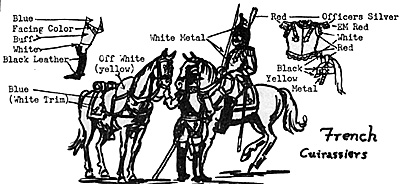
It has been our habit, for the most part, to avoid giving uniform data on fairly well known basic types of troops. However, with the advent of the airfix Napoleonics it would seem that many cuirassiers are likely to fall into the hands or people who lack the basic uniform data for that type, resulting in the problem described by & cavalry officer during a great mobilization who reported to his superiors: "I have forty recruits who have never seen a horse and forty horses who have never seen a recruit."
So we offer this article by way of introduction.
The cuirassier coat was of dark blue and of the short tailed pattern long before that pattern became common to other branches of Napoleon's army. The button color, which rarely shows, was silver. The breastplate and helmet were of beaten and polished iron, showing silver. Showing like a fringe around all edges of' the breastplate is portion of the harness, red trimmed white. Straps over the shoulder are of red leather trimmed brass. The crest on the helmet is brass surmounted by a black tuft with a red plume on the side (by Waterloo the plume had been replaced by a disk.) The epaullettes of the enlisted men and the pointed trim on the sheepskin saddle cover were red in all regiments. After 1809 the facing colors of regiments 1,2,3, were scarlet, 4,5,6 ware salmon pink, 7,8,9, Pale Yellow, 10,11, 12, Rose, 13, 14 Dark Claret. Turnbacks were always in the facing color. Other distinctions as follows:
| Regiment | Collar | Piping | Cuff | Piping | Cuff Flap | Piping |
|---|---|---|---|---|---|---|
| 1 | Facing | blue | Facing | - | Facing | - |
| 2 | Facing | blue | Facing | - | Blue | facing |
| 3 | Facing | blue | Blue | Facing | Facing | - |
| 4 | Facing | blue | Facing | - | facing | - |
| 5 | Facing | blue | facing | - | Blue | facing |
| 6 | Facing | blue | Blue | Facing | facing | - |
| 7 | Facing | blue | Facing | - | Facing | - |
| 8 | Facing | blue | Facing | - | Blue | facing |
| 9 | Facing | blue | Blue | Facing | Facing | - |
| 10 | Facing | blue | Facing | - | Facing | - |
| 11 | Facing | blue | Facing | - | blue | Facing |
| 12 | Facing | blue | blue | Facing | facing | - |
| 13 | Facing | blue | Facing | - | Facing | - |
| 14 | Facing | blue | Facing | - | blue | Facing |
Trousers, as shown in the Airfix figures are buckskin with a white linen protector emerging slightly above the polished black jackboots. Alternatively, gray overalls buttoning on the side were worn, sometimes with a thin red stripe down the seam. In winter these are illustrations and some flat figures showing the overalls worn over the boots.
The saddle cloth is dark blue trimmed white, the trim being silver for officers with a double silver band for senior officers. The mantlesack on back or saddle is blue edged white with overcoat voided ever it. The overcoat is white edged facing color.
The band around the steel colored helmet is of black fur.
Some sources give the color of the wolfstooth trim on the sheepskin saddle cover as the regimental facing color. This sounds good. I was going by single illustrations in the first case, and these are often in error or represent nonstandard patterns.
Trumpeters: None provided. They did not wear the cuirass breastplate, so they are best converted from dragoons. Scruby casting Dragoon with the saber clipped and bent back over the hand and a straight pin clipped and glued across (using pin head for bell or trumped) should do the job.
By Waterloo the cuirassiers had been converted to imperial livery. Previously the trumpeters usually were reversed colors (coat in facing color, collar and curl's in blue.) I have seen reversed colors in Phillipoteaux's Waterloo paintings which should not be surprising. The Imperial livery was Napoleon's court dress and unlikely to be kept up during the brief restoration. it was to have been common to all field music in the Grand Army regardless of branch and arm. Imperial Livery was also perhaps the low point of costume design in an empire frequently criticized for garish bad taste. If you persist in putting your musicians into imperial livery the coat was dark green, collar, cuffs, and turnbacks in facing color,all edged in silvery lace with similar lacing across the breast and 7 loops of the silly stuff down each arm. This lace was yellow edged red with alternate N's and eagles of deep green separated by bleak bonds. Trumpet cords of green and yellow with red helmet plume. The guy who tries to do that in 20mm...well, let's just may it makes painting kilts look easy.
Back to The Armchair General Vol. 2 No. 3 Table of Contents
Back to The Armchair General List of Issues
Back to MagWeb Master Magazine List
© Copyright 1969 by Pat Condray
This article appears in MagWeb (Magazine Web) on the Internet World Wide Web. Other military history articles and gaming articles are available at http://www.magweb.com
